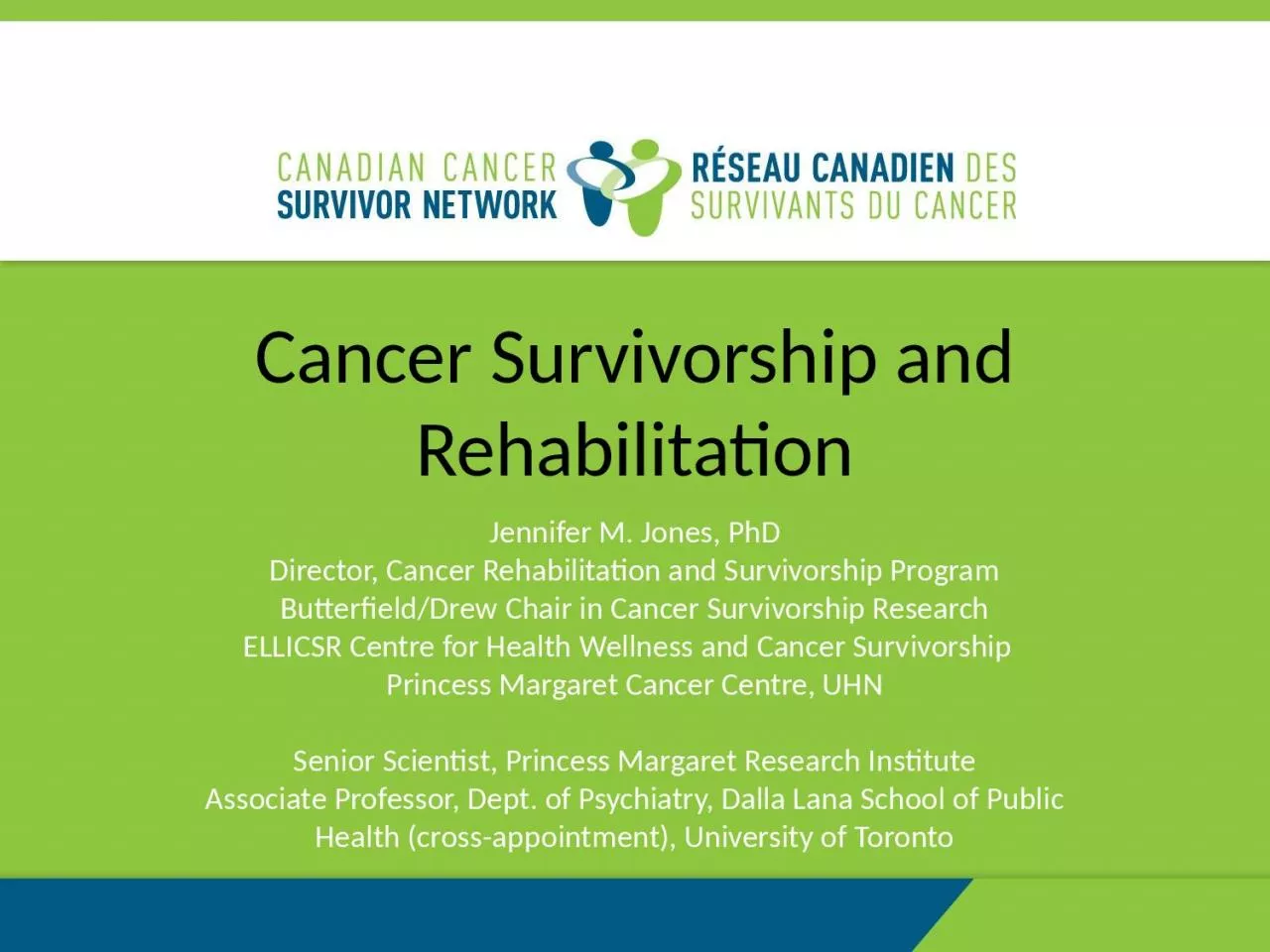

Jennifer M Jones PhD Director Cancer Rehabilitation and Survivorship Program ButterfieldDrew Chair in Cancer Survivorship Research ELLICSR Centre for Health Wellness and Cancer Survivorship ID: 1041092
Download Presentation The PPT/PDF document "Cancer Survivorship and Rehabilitation" is the property of its rightful owner. Permission is granted to download and print the materials on this web site for personal, non-commercial use only, and to display it on your personal computer provided you do not modify the materials and that you retain all copyright notices contained in the materials. By downloading content from our website, you accept the terms of this agreement.
1. Cancer Survivorship and RehabilitationJennifer M. Jones, PhDDirector, Cancer Rehabilitation and Survivorship ProgramButterfield/Drew Chair in Cancer Survivorship ResearchELLICSR Centre for Health Wellness and Cancer Survivorship Princess Margaret Cancer Centre, UHNSenior Scientist, Princess Margaret Research InstituteAssociate Professor, Dept. of Psychiatry, Dalla Lana School of Public Health (cross-appointment), University of Toronto
2. Cancer Survivorship by numbersCanadian Cancer Statistics 2018
3. The good news…mortality rates have dropped significantly tobacco control, early detection and better treatmentsfive-year age-standardized RSR for cancers combined is 63% when measured from the date of diagnosisincreases to 81% when measured among those who survived the first year after a cancer diagnosis
4. Canadian Cancer Statistics 2014
5. Survival…but at a cost“The experience of entering the medical system for many cancer patients is that they feel very good at the beginning, and then the treatments make them profoundly ill and often disabled. When they are sicker and more debilitated than they have ever been, they are discharged to follow-up care, which may include such things as routine screening for cancer recurrence, managing ongoing medications, and others, but this does not generally include a multidisciplinary rehabilitation intervention. In effect, the medical system creates a situation where high-functioning individuals are given life-prolonging treatments and then left to struggle with how to recover from the toxic adverse effects of these therapies”.Silver and Gilchrist 2011Dx
6. Challenges Facing Cancer SurvivorsAll major types of cancer treatment can result in side-effects that can impair well-being, physical and psychosocial functioning and overall quality of life and may last after treatment ends (persistent treatment effects)New side-effects may also manifest months or even years after treatment ends (late treatment effects)Often go undetected and undertreated and can diminish survivors ability to participate fully in work and life roles and reduce overall quality of life 40% of cancer survivors report difficulties in basic activities of daily living (e.g., bathing, dressing)55-60% report limitations in instrumental ADLs (e.g., preparing meals, household chores
7. Prevalence and severity of physical, emotional and practical concerns after cancer treatment (2016)Data source: Experiences of Cancer Patients in Transition study (2016)
8. Need for Cancer Rehabilitation and Wellness ProgramsThe increasing number of cancer survivors, along with the growing evidence documenting the lasting effects of treatments, serves as an urgent call to action — to invest in the recovery and well-being of cancer survivors and help them get back to life after cancer.Outpatient cancer rehabilitation is not currently funded in Ontario.
9. Cancer PainOne the most prevalent and persistent problems reported by cancer patients and survivors Prevalence rates: 55% of patients during cancer treatment; 66% of patients with advanced cancer; and 40% after curative treatment Pain can interfere with activities of daily life, quality of life and fulfillment of a person’s role in society Pain during, and especially after, cancer remains underestimated and undertreated
10. Role of Cancer Rehab and PainPharmacological treatment is considered the standard approach for treating pain related to cancer Rehab interventions can also be helpful including: educational interventions, specific exercise therapies, manual therapies, general exercise therapies and mind-body exercise therapies (yoga, mindfulness).